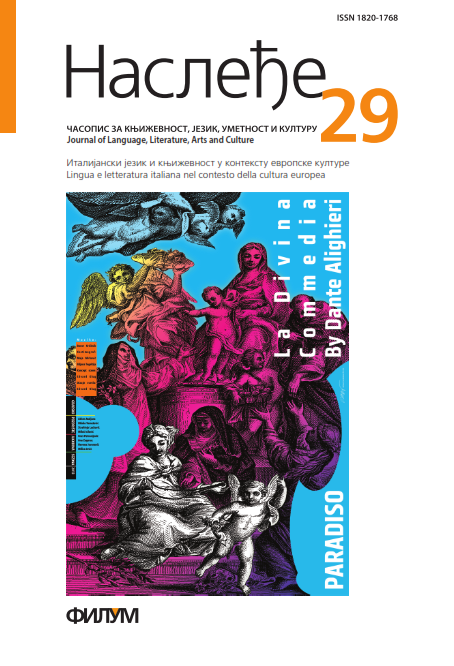PARALLELIZED LITERARY TEXTS AND EVALUATING TRANSLATION
THE CASE OF PUNCTUATION
Keywords:
Serbian novels, translation into Italian, parallel texts, bitext, translation analysis, evaluating translation, punctuationAbstract
This paper approaches the process of evaluating literary translations (from Serbian into Italian) and proposes the idea of introducing it into the analysis of punctuation in both original and translated texts. The translated text should replicate the rhythm of the original prose, which is also visible through punctuation, a graphic element that aims to convey author’s hierarchy of ideas, images and contents; since Serbian and Italian share many structural similarities, these elements should be preserved in translation. A comparison was made between the original text of Adrić’s Chronicle of Travnik and its Italian translation (by Dunja Badnjević), both parallelized and hence easy to analyze. A quick survey of this bitext showed that approximately 592 sentences contain a different punctuation on an estimated total of 7221 sentences. This paper shows some of the places in which punctuation varies in the translated text. A possible conclusion of this research is that translators should observe original punctuation, resulting from the rhythm and the syntax of the prose, varying it only in cases when specific linguistic factors require different solutions. One of the criteria of evaluating a literary translation should be, among others, the precision applied in transferring punctuation from one text to the other. This criterion can be expressed numerically and can be adopted as one of the objective and quantitative criteria in evaluating a literary translation, especially when the original text and its translation exist in the form of a bitext.
References
Baker 1996: M. Baker, Corpus-based translation studies: The challenges that lie ahead. In: Harold Somers (a cura di). Terminology, LSP and Translation, John Benjamins Publishing Co, 175-185.
Foremniak 2011: K. Foremniak, A che punto siamo con la punteggiatura?: Romanica. doc. n. 3(4)/2011.
Malone 1988: J. L. Malone: The Science of Linguistics in the Art of Translation, State University of New York Press.
Mortara Garavelli 2008: B. Mortara Garavelli Bice (a cura di), Storia della punteggiatura in Europa, Roma-Bari, Laterza, 2008
Scott 2010: C. Scott, Re-theorizing the Literary in Literary Translation, in: Antoinette Fawcett, Karla L. guadarrama garcía, Rebecca Hyde Parker (a cura di), Translation: Theory and Practice in Dialogue, Continuum Studies in Translation, 109-127.
Svolacchia 2007: M. Svolacchia, La punteggiatura tra restrizioni e creatività: Cadmo, Voll. n. 2, 41-70.
Tonani 2010: E. Tonani, Il romanzo in bianco e nero. Ricerche sull’uso degli spazi bianchi e dell’interpunzione nella narrativa italiana dall’Ottocento a oggi. Strumenti di linguistica italiana, 4, Firenze: Franco Cesati editore.
Venuti 2008: L. Venuti, Translation, Interpretation, Canon Formation, in: Lianeri Alexandra- zajko vanda (a cura di), Translation and the Classic, Oxford: Oxford University Press, 27-51.






